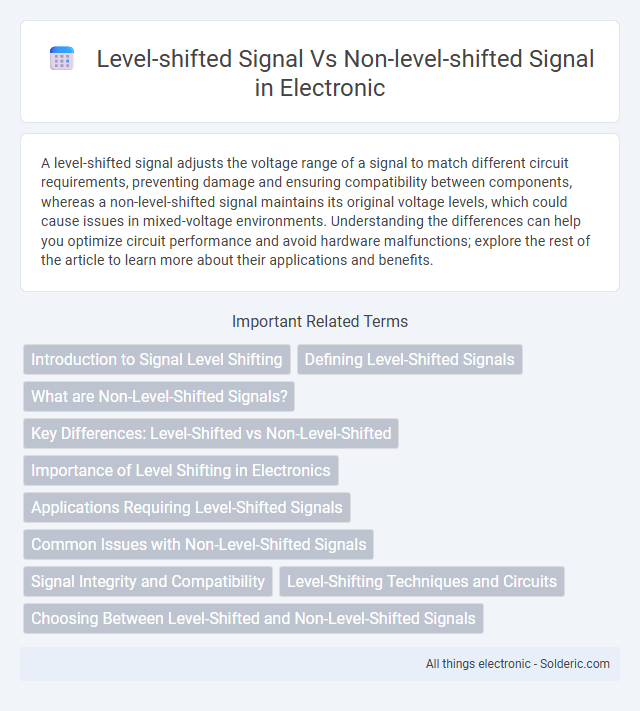A level-shifted signal adjusts the voltage range of a signal to match different circuit requirements, preventing damage and ensuring compatibility between components, whereas a non-level-shifted signal maintains its original voltage levels, which could cause issues in mixed-voltage environments. Understanding the differences can help you optimize circuit performance and avoid hardware malfunctions; explore the rest of the article to learn more about their applications and benefits.
Comparison Table
| Feature | Level-Shifted Signal | Non-Level-Shifted Signal |
|---|---|---|
| Definition | Signal with adjusted voltage levels for compatibility | Signal at original voltage level without adjustment |
| Voltage Compatibility | Compatible with different logic families and voltage domains | May cause damage or malfunction if voltages differ |
| Signal Integrity | Improved signal integrity across devices | Potential signal distortion and noise |
| Application | Used in interfacing circuits with different supply voltages | Used when devices share the same voltage levels |
| Complexity | Requires additional components like level shifters or translators | Simpler circuit design |
| Power Consumption | Typically higher due to extra components | Lower power consumption |
Introduction to Signal Level Shifting
Signal level shifting is a technique used to adjust the voltage levels of a signal to match the input requirements of different electronic components or systems, enabling proper interfacing and communication. Level-shifted signals ensure compatibility between devices operating at different logic levels, preventing damage and signal misinterpretation. Non-level-shifted signals can lead to improper operation or failure when interfacing components with incompatible voltage ranges.
Defining Level-Shifted Signals
Level-shifted signals refer to electrical signals whose voltage levels are intentionally offset to match the input requirements of subsequent electronic stages or components, preventing incorrect interpretation or damage. Unlike non-level-shifted signals that maintain their original voltage range, level-shifted signals are adjusted using circuits like level shifters or voltage translators to provide compatibility between differing logic families or voltage domains. Understanding the need for level shifting enhances Your ability to design robust and reliable electronic systems where signal integrity and proper communication across varying voltage levels are critical.
What are Non-Level-Shifted Signals?
Non-level-shifted signals maintain their original voltage reference without any adjustment to shift the signal level, meaning the signal's zero point remains fixed relative to the system ground. These signals are commonly used where the input and output devices share the same ground reference, allowing for straightforward interpretation by circuits without requiring additional level translation. Understanding non-level-shifted signals is crucial for designing interfaces that rely on consistent voltage baselines to ensure signal integrity and proper functionality in your electronic systems.
Key Differences: Level-Shifted vs Non-Level-Shifted
Level-shifted signals incorporate a DC voltage offset to adjust the signal's baseline, enabling compatibility with circuits operating at different reference voltage levels. Non-level-shifted signals lack this offset, maintaining their original voltage range, which may cause interface issues when connecting devices with mismatched voltage domains. Understanding these differences helps you optimize signal integrity and ensure seamless communication between components in mixed-voltage systems.
Importance of Level Shifting in Electronics
Level shifting is crucial in electronics for interfacing components operating at different voltage levels, ensuring signal integrity and preventing damage. Without level shifting, signals from low-voltage devices may not be recognized correctly by higher-voltage logic circuits, leading to communication failures. Proper level shifting enhances system compatibility and reliability, especially in mixed-voltage environments like microcontroller-based systems and modern digital circuits.
Applications Requiring Level-Shifted Signals
Applications requiring level-shifted signals often include interfacing between different voltage domains in mixed-signal circuits, such as communication between 3.3V logic and 5V microcontrollers. Level shifting is critical in sensor interfacing, where output signals from sensors operating at low voltage levels must be translated to higher voltage levels for microcontroller ADC inputs. Power management systems and battery-operated devices also rely on level-shifted signals to ensure compatibility and protect sensitive components from voltage mismatches.
Common Issues with Non-Level-Shifted Signals
Non-level-shifted signals often suffer from issues like signal distortion, limited voltage range compatibility, and increased noise susceptibility, which can degrade overall system performance. These signals may cause incorrect logic level interpretation, leading to malfunction in digital circuits or reduced accuracy in analog systems. Ensuring your design incorporates level shifting can prevent voltage mismatches and improve signal integrity across varied components.
Signal Integrity and Compatibility
Level-shifted signals improve signal integrity by aligning voltage levels between different logic families, reducing the risk of signal distortion or data loss during transmission. Non-level-shifted signals may suffer from compatibility issues, causing improper voltage interpretation and potential circuit malfunction. Proper level shifting ensures robust interfacing between digital components with varying voltage domains, enhancing overall system reliability.
Level-Shifting Techniques and Circuits
Level-shifting techniques include resistor dividers, transistor-based circuits, and specialized level shifter ICs that adjust voltage levels between different logic families or supply domains. CMOS level shifters use complementary transistor pairs to translate signals without significant delay or power loss, while diode or resistor-based methods rely on voltage drops but offer less precision. Advanced circuits such as bidirectional level shifters enable communication between devices operating at different voltages, crucial for modern mixed-voltage systems in microcontrollers and digital interfaces.
Choosing Between Level-Shifted and Non-Level-Shifted Signals
Choosing between level-shifted and non-level-shifted signals depends on your system's voltage compatibility and noise margin requirements. Level-shifted signals adjust voltage ranges to match different logic families or devices, improving signal integrity and reducing distortion in mixed-voltage environments. Non-level-shifted signals maintain original voltage levels, suitable for uniform systems where signal timing and simplicity are prioritized.
level-shifted signal vs non-level-shifted signal Infographic

 solderic.com
solderic.com